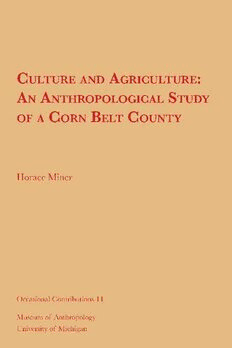Table Of ContentOCCASIONAL CONTRIBUTIONS FROM THE MUSEUM OF
ANTHROPOLOGY OF THE UNIVERSITY OF MICHIGAN
NO. 14
CULTURE AND AGRICULTURE
An Anthropological Study of
a Corn Belt County
BY
HORACE MINER
ANN ARBOR
UNIVERSITY OF MICHIGAN PRESS
1949
© 1949 by the Regents of the University of Michigan
The Museum of Anthropology
All rights reserved
ISBN (print): 978-1-949098-50-1
ISBN (ebook): 978-1-951538-49-1
Browse all of our books at
sites.lsa.umich.edu/archaeology-books.
Order our books from the University of Michigan
Press at www.press.umich.edu.
For permissions, questions, or manuscript queries,
contact Museum publications by email at umma-
[email protected] or visit the Museum website at
lsa.umich.edu/ummaa.
PREFACE
THE following study germinated in a series of conferences on
cultural anthropology held during May, 1939, in the office of
Undersecretary M. L. Wilson, of the United States Department
of Agriculture. It was the desire of the undersecretary to ascer
tain if the functional analyses of society and the concept of.
culture utilized by certain sociologists and anthropologists
could be fruitfully applied to problems of the Department.
The conclusion of the conference was that the cultural ap
proach might give the Department new insight into farm life
and its problems. To pursue this end, Dr. Carl C. Taylor,
head of the Division of Farm Population and Rural Welfare,
was authorized to start a series of studies of characteristic farm
areas.
This first study was almost exploratory in its initial design.
The actual purposes and emphases were evolved as the study
progressed. This process was assisted by conferences with
Doctors C. C. Taylor, John Provinse, Charles P. Loomis, Ralph
Danhof, all then of the Department of Agriculture, and with
Professors Robert Redfield and Lloyd Warner, of the University
of Chicago, who acted in an advisory capacity.
I am, likewise, indebted for courteous assistance in this study
to Professor Ray Wakeley, of Iowa State College; Mr. Walter
Eyre, county agent of Hardin County; and Mr. Herbert G.
Folken, acting Bureau of Agricultural Economics representa
tive in Iowa.
The field period consisted of less than four months' residence
and study in Hardin County, beginning August I and ending De
cember 15, 1939, with about three weeks out of the county for
conferences and other Department of Agriculture activity. The
report on the study was submitted to the Department of Agri
culture in 1940 in practically the same form as it appears here.
The attempt to make a community study bear upon the
implications of a controversial national governmental policy
was a tactical error, considering the fact that the study was
lll
lV PREFACE
made for a division of a government bureau involved in the
policy. This report immediately stirred up controversy over the
advisability of publication. The head of the division ultimately
decided to publish the study, but it was "lost" in the shifts
occurring during his absence in South America. Subsequent
studies were more carefully oriented and edited before publica
tion in the series of Rural Life Studies. In spite of precautions,
a political furore of such magnitude developed over one study
that the division has been forbidden to publish any more cul
tural surveys. Under these circumstances the head of the divi
sion has kindly consented to release the material of this report
for publication. The point of view expressed in the monograph
is obviously mine and not that of the Department of Agricul
ture.
CONTENTS
I.
PROBLEM AND METHOD I
II. EARLY AND RECENT HISTORY 8
III. THE SoiL AND THE PEoPLE 29
IV. FARM LIFE • • • • 37
V. SociAL AcTION AND CuLTURAL REACTION. 75
REFERENCES 95
v
I
PROBLEM AND METHOD
UPoN the initiation of this study, the problem proposed by the
Department of Agriculture was no more specifically defined
than "the application of the cultural approach to the study of
farm life in the corn belt." Determination of the unit of inves
tigation and, even more important, the emphases of the study
were the preliminary part of the work.
The first decision made was to choose between a study de
signed to isolate the typical elements of a culture area, and an
intensive study of the culture of a community chosen from a
certain area. In spite of the apparent logical necessity of first
distinguishing a culture area, this line of investigation was not
followed. This decision was made for several reasons: (I) The
spatial definition of a culture area and the delimitation of typical
traits of that area consist of the recognition of traits present
in various contiguous communities-in this sense the study of
the community must precede that of the culture area, (2) in
the study of a community, the culture can be treated as a whole
and the interrelationship of its parts analyzed, which is the
essence of the functional approach in which the Department of
Agriculture was interested, and (3) a type of culture area study
was already available which could be made the basis of selection
of a sample community.
The study undertaken, therefore, was an attempt to add to
our knowledge of the totality of a type of American culture of
which corn-livestock agricultural economy is one phase. The
method was the analysis of a selected community of that gen
eral economic type. This does not imply that the particular
community studied is representative or typical of all rural com
munities based on this sort of economy. An attempt was made
to choose a community which would possess as many of the fea
tures common to corn-belt farmers as possible. In selecting the
community for study, cultural islands, unique developments
of unusual geographic features, farm areas on an economic base

